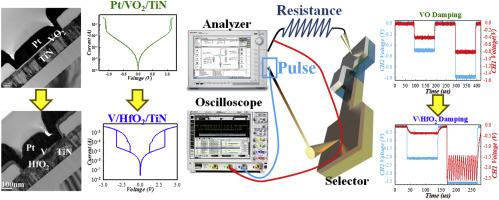当前位置:
X-MOL 学术
›
Mater. Today Phys.
›
论文详情
Our official English website, www.x-mol.net, welcomes your
feedback! (Note: you will need to create a separate account there.)
A Comprehensive Study of Enhanced Characteristics with Localized Transition in Interface-type Vanadium-based Devices
Materials Today Physics ( IF 10.0 ) Pub Date : 2020-06-01 , DOI: 10.1016/j.mtphys.2020.100201 C.-Y. Lin , P.-H. Chen , T.-C. Chang , W.-C. Huang , Y.-F. Tan , Y.-H. Lin , W.-C. Chen , C.-C. Lin , Y.-F. Chang , Y.-C. Chen , H.-C. Huang , X.-H. Ma , Y. Hao , S.M. Sze
Materials Today Physics ( IF 10.0 ) Pub Date : 2020-06-01 , DOI: 10.1016/j.mtphys.2020.100201 C.-Y. Lin , P.-H. Chen , T.-C. Chang , W.-C. Huang , Y.-F. Tan , Y.-H. Lin , W.-C. Chen , C.-C. Lin , Y.-F. Chang , Y.-C. Chen , H.-C. Huang , X.-H. Ma , Y. Hao , S.M. Sze

|
Abstract In this research, we investigated the conduction mechanism in metal-insulator transition (MIT) materials. Among these MIT materials (NbOx, NiOx, VOx, and TaS2), vanadium oxide–based selectors have been widely investigated because of their high switching speed (~10-ns transition time), sufficient non-linearity (>103), and endurance stability (~1010). Abnormal temperature-dependent degradation in the high resistive state was observed, as was studied in detail by a current fitting analysis and explored theoretically by electric (E-MIT) and thermal (T-MIT) modeling. The results suggest the existence of a MIT region located between the electrode and the localized filament. To improve the localized transition efficiency, we propose an enhanced-type MIT architecture to bypass the E-MIT and T-MIT universal rule with the novel structure of vanadium top electrode device. As compared with a vanadium oxide middle-layer device, the electrical transition efficiency is improved 2-fold as evidenced by thermal cycling material analysis, as well as boosting endurance reliability to 107 at 65 °C. Finally, for the first time, a potential neuromorphic computing application featuring a damping oscillator has been demonstrated in this enhanced-type MIT architecture, with a high damping ratio with 10-fold smaller area and 5-fold smaller energy than complementary metal–oxide–semiconductor (CMOS) devices. This presents a promising milestone for ultralow power neuromorphic system design and solutions in the near future.
中文翻译:

界面型钒基器件局部跃迁增强特性的综合研究
摘要 在这项研究中,我们研究了金属-绝缘体过渡 (MIT) 材料的导电机制。在这些 MIT 材料(NbOx、NiOx、VOx 和 TaS2)中,基于氧化钒的选择器因其高开关速度(~10 ns 转换时间)、足够的非线性 (>103) 和耐用性而受到广泛研究稳定性(~1010)。通过电流拟合分析进行了详细研究,并通过电 (E-MIT) 和热 (T-MIT) 建模进行了理论探索,观察到了高电阻状态下的异常温度相关退化。结果表明存在位于电极和局部灯丝之间的 MIT 区域。为了提高本地化的转换效率,我们提出了一种增强型 MIT 架构,以通过钒顶部电极器件的新颖结构绕过 E-MIT 和 T-MIT 通用规则。热循环材料分析证明,与氧化钒中间层器件相比,电转换效率提高了 2 倍,并且在 65°C 下将耐久性可靠性提高到 107。最后,首次在这种增强型 MIT 架构中展示了具有阻尼振荡器的潜在神经形态计算应用程序,它具有高阻尼比,面积比互补金属氧化物小 10 倍,能量小 5 倍。半导体 (CMOS) 器件。在不久的将来,这为超低功耗神经形态系统设计和解决方案提供了一个有希望的里程碑。热循环材料分析证明,与氧化钒中间层器件相比,电转换效率提高了 2 倍,并且在 65°C 下将耐久性可靠性提高到 107。最后,首次在这种增强型 MIT 架构中展示了具有阻尼振荡器的潜在神经形态计算应用程序,它具有高阻尼比,面积比互补金属氧化物小 10 倍,能量小 5 倍。半导体 (CMOS) 器件。在不久的将来,这为超低功耗神经形态系统设计和解决方案提供了一个有希望的里程碑。热循环材料分析证明,与氧化钒中间层器件相比,电转换效率提高了 2 倍,并且在 65°C 下将耐久性可靠性提高到 107。最后,首次在这种增强型 MIT 架构中展示了具有阻尼振荡器的潜在神经形态计算应用程序,它具有高阻尼比,面积比互补金属氧化物小 10 倍,能量小 5 倍。半导体 (CMOS) 器件。在不久的将来,这为超低功耗神经形态系统设计和解决方案提供了一个有希望的里程碑。在这种增强型 MIT 架构中展示了一种具有阻尼振荡器的潜在神经形态计算应用,与互补金属氧化物半导体 (CMOS) 器件相比,它具有高阻尼比,面积小 10 倍,能量小 5 倍。在不久的将来,这为超低功耗神经形态系统设计和解决方案提供了一个有希望的里程碑。在这种增强型 MIT 架构中展示了一种具有阻尼振荡器的潜在神经形态计算应用,与互补金属氧化物半导体 (CMOS) 器件相比,它具有高阻尼比,面积小 10 倍,能量小 5 倍。在不久的将来,这为超低功耗神经形态系统设计和解决方案提供了一个有希望的里程碑。
更新日期:2020-06-01
中文翻译:

界面型钒基器件局部跃迁增强特性的综合研究
摘要 在这项研究中,我们研究了金属-绝缘体过渡 (MIT) 材料的导电机制。在这些 MIT 材料(NbOx、NiOx、VOx 和 TaS2)中,基于氧化钒的选择器因其高开关速度(~10 ns 转换时间)、足够的非线性 (>103) 和耐用性而受到广泛研究稳定性(~1010)。通过电流拟合分析进行了详细研究,并通过电 (E-MIT) 和热 (T-MIT) 建模进行了理论探索,观察到了高电阻状态下的异常温度相关退化。结果表明存在位于电极和局部灯丝之间的 MIT 区域。为了提高本地化的转换效率,我们提出了一种增强型 MIT 架构,以通过钒顶部电极器件的新颖结构绕过 E-MIT 和 T-MIT 通用规则。热循环材料分析证明,与氧化钒中间层器件相比,电转换效率提高了 2 倍,并且在 65°C 下将耐久性可靠性提高到 107。最后,首次在这种增强型 MIT 架构中展示了具有阻尼振荡器的潜在神经形态计算应用程序,它具有高阻尼比,面积比互补金属氧化物小 10 倍,能量小 5 倍。半导体 (CMOS) 器件。在不久的将来,这为超低功耗神经形态系统设计和解决方案提供了一个有希望的里程碑。热循环材料分析证明,与氧化钒中间层器件相比,电转换效率提高了 2 倍,并且在 65°C 下将耐久性可靠性提高到 107。最后,首次在这种增强型 MIT 架构中展示了具有阻尼振荡器的潜在神经形态计算应用程序,它具有高阻尼比,面积比互补金属氧化物小 10 倍,能量小 5 倍。半导体 (CMOS) 器件。在不久的将来,这为超低功耗神经形态系统设计和解决方案提供了一个有希望的里程碑。热循环材料分析证明,与氧化钒中间层器件相比,电转换效率提高了 2 倍,并且在 65°C 下将耐久性可靠性提高到 107。最后,首次在这种增强型 MIT 架构中展示了具有阻尼振荡器的潜在神经形态计算应用程序,它具有高阻尼比,面积比互补金属氧化物小 10 倍,能量小 5 倍。半导体 (CMOS) 器件。在不久的将来,这为超低功耗神经形态系统设计和解决方案提供了一个有希望的里程碑。在这种增强型 MIT 架构中展示了一种具有阻尼振荡器的潜在神经形态计算应用,与互补金属氧化物半导体 (CMOS) 器件相比,它具有高阻尼比,面积小 10 倍,能量小 5 倍。在不久的将来,这为超低功耗神经形态系统设计和解决方案提供了一个有希望的里程碑。在这种增强型 MIT 架构中展示了一种具有阻尼振荡器的潜在神经形态计算应用,与互补金属氧化物半导体 (CMOS) 器件相比,它具有高阻尼比,面积小 10 倍,能量小 5 倍。在不久的将来,这为超低功耗神经形态系统设计和解决方案提供了一个有希望的里程碑。











































 京公网安备 11010802027423号
京公网安备 11010802027423号